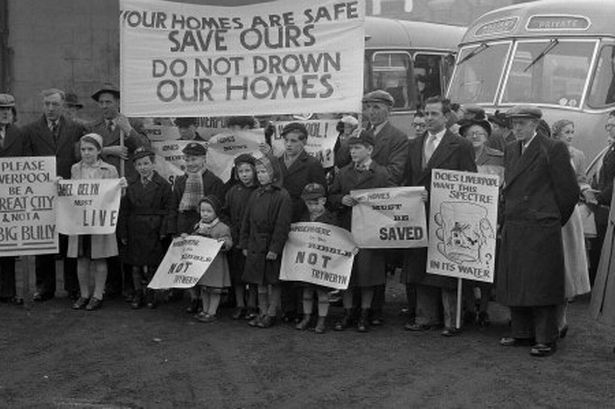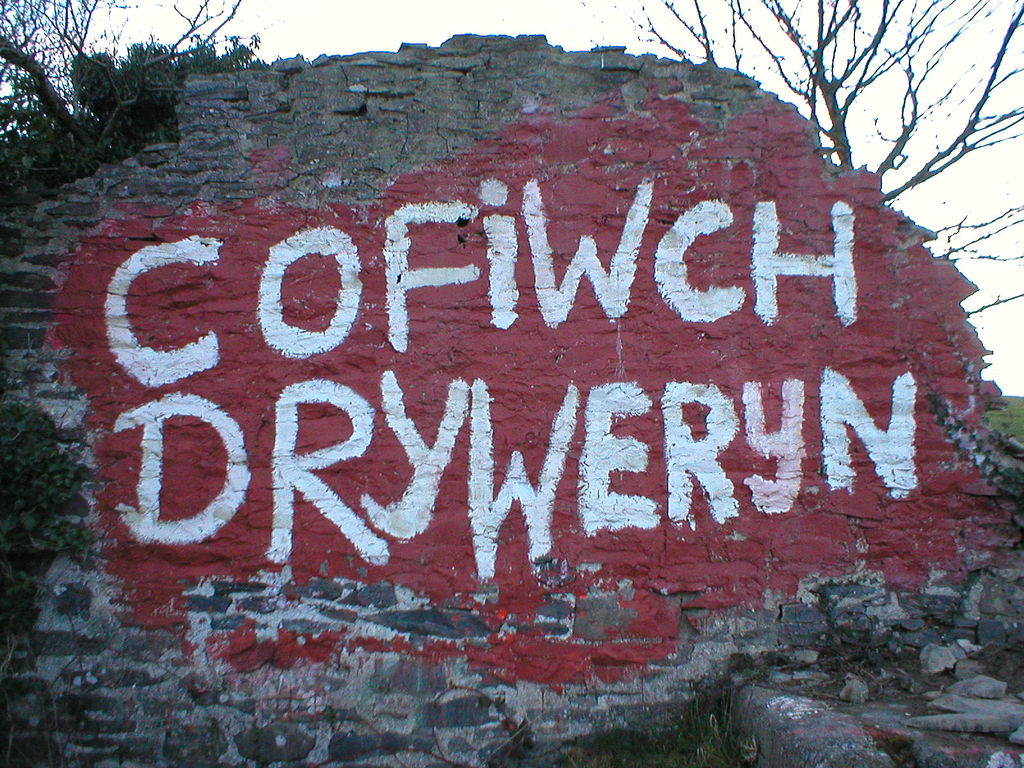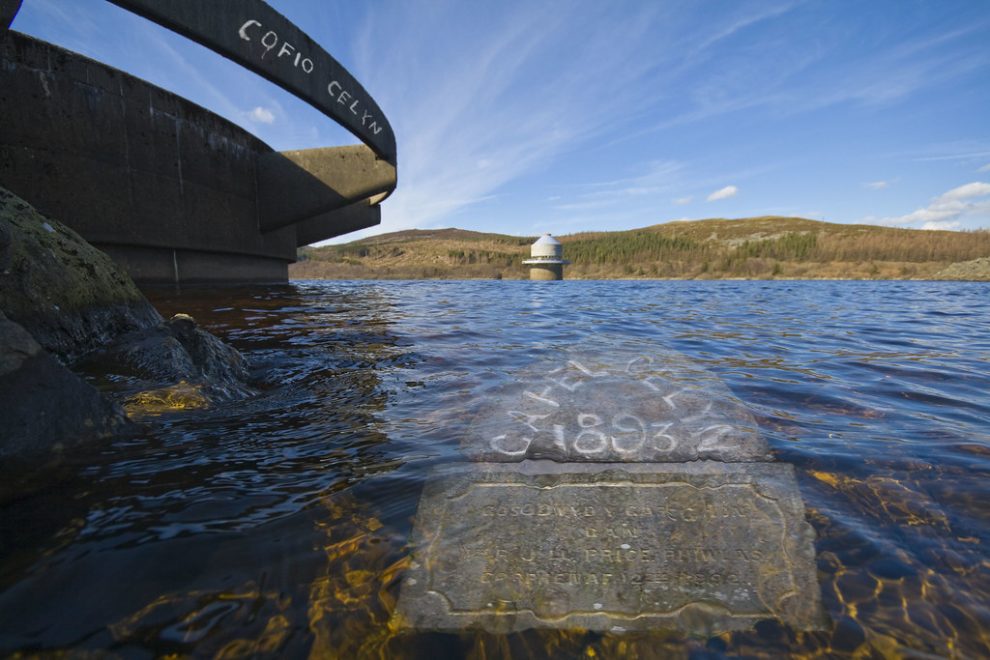IN 2021, the idea of a village being flooded to supply a city over the border with water sounds like an evil plot for a comic book.
But for dozens of families in North Wales, this was a sad reality many decades ago.
And the plan didn’t come from a super villain, but was backed by the UK Government, with nothing for the Welsh to do to stop the plans.
The water supplied to Liverpool and Wirral comes from a reservoir in North Wales – but under the surface lies the remains of an underwater village with a haunting past.
It can only be seen when the water level is low, but the history of this long lost village involves a community uprooted and mass protest.

When the Tryweryn Valley, where the village was located, was flooded, the village and its buildings, including the post office, the school, and a chapel with cemetery, were all lost.
A further 12 houses and farms were submerged, and 48 people of the 67 who lived in the valley lost their homes.
The remains of some of these buildings can still be seen when the water levels are low enough, and offer a haunting reminder of the lives which were forcibly uprooted all those decades ago.
The decision to flood the Tryweryn Valley and destroy an entire community prompted fierce opposition at the time.

In the mid 1950s, Liverpool desperately needed additional water as town planners struggled to source water for the city’s busy port and slum housing.
The city had previously used Wales to source its water supply, and another lost village called Llanwyddyn was flooded in 1888 to provide drinking water.
Capel Celyn, a village home to 67 people and one of the last Welsh-only speaking communities, stood in the Trweryn Valley which became the proposed site for the new reservoir.

Rather than applying to local planning committees to build the reservoir, Liverpool City Council sponsored a bill in Parliament, meaning Welsh political opposition couldn’t stop approval of the scheme.
In 1957, a bill for the construction of the reservoir passed through the Houses of Parliament and was approved despite 35 of the 36 Welsh MPs voting against it.
The end result was 800 acres and an entire village being flooded – and it triggered fierce opposition and a campaign of Welsh nationalist civil disobedience.
“It was a very happy community life,” said Eurgain Prysor Jones. “Everybody knew one another and we used to walk to other children’s houses to play.”
“To us as children it was a very unsettling time. We didn’t quite realise what was happening but we knew our home would be gone, our chapel would be gone, our school would be gone and our friends would be moved to different parts.
“People came to see the village before it was drowned and they used to say, ‘Oh isn’t it traumatic? Isn’t it awful you’re going to lose your home? What’s going to happen? Where are you going to live?'”
Her older brother Aeron agrees it was a harrowing time: “Everything that takes place when you’re a certain age seems to mould your character and I suppose that’s what it’s done to me.
“You remember where everything was and the people that you link with certain spots within the valley. It makes you wonder with 50 years gone, what might have been if the valley hadn’t been flooded.”
In November 1956, Eurgain became the youngest protestor in a march on Liverpool Town Hall: “I was three years old and the oldest lady was over 80 years old. I had a massive poster to carry which was bigger than me, really.
“The reception we had in Liverpool was awful. People were spitting at us and throwing rotten tomatoes at us. It was an awful disappointment.
“Although it was a brave fight at the time, it was probably a very, very simple protest and it might have been just a way of giving the community peace of mind that they’d done all they could,” said Aeron.
“At the end of the day, the eventual consequence was written before it was started.”
In early 1963, when the dam was still under construction, the protests turned violent.
Aberystwyth student Emyr Llewelyn, farmer’s son Owain Williams and former RAF military policeman John Albert Jones formed Mudiad Amddiffyn Cymru – the Movement for the Defence of Wales.
On the night of February 9th they travelled through blizzard conditions to plant a 2.3kg bomb which destroyed an electricity transformer on the site.
Emyr Llewelyn was later sentenced to 12 months in prison for the attack.
Owain Williams and John Albert Jones were jailed following a second bombing which destroyed a pylon at Gellilydan near Trawsfynydd in Gwynedd.
“It was something that had to be done,” said Mr Williams, now a Gwynedd county councillor. “None of us wanted to do it but somebody had to stand up and do something.
“I was married with three children, one a small baby, and my marriage broke up shortly after I was imprisoned. The family was split. It had its effect, there’s no question about that.
“But the action had to be taken. There was no alternative at the time because the Welsh had been pumped with Calvanistic Methodism and other kinds of religion and non-violence for years and maybe it was time we stood up and said, ‘Yes, we’re here’.
“It was a political awakening for Wales, a seed planted to develop for the future, when we would have some kind of democratic defence.”
Aeron Prysor Jones agrees: “This project, no doubt about it, ignited the nationalist cause within Wales and there would be uproar if they tried to do something similar again.”
Did actions like this lead to the creation of the Welsh Assembly? Former First Minister, Rhodri Morgan, says no.
“I think there’s a little bit of nationalist myth-making here.
“The time gap between Tryweryn and the assembly is just too long to make that connection. I certainly don’t remember it coming up once during the ’97 referendum.
“I don’t think it made an impact in south Wales because the concerns were really quite different. Tryweryn was probably a second-order issue because it was a dam-building period. Every big city was building a dam somewhere.”
The valley was eventually flooded in 1965 – and any evidence of its existence can only been seen during heatwave conditions when the reservoir dries out.
Forty years after the opening of the reservoir, in 2005, Liverpool City Council issued an apology for Tryweryn, stating: “We realise the hurt of 40 years ago when the Tryweryn Valley was transformed into a reservoir to help meet the water needs of Liverpool.
“For any insensitivity by our predecessor council at that time, we apologise and hope that the historic and sound relationship between Liverpool and Wales can be completely restored.”




















Add Comment